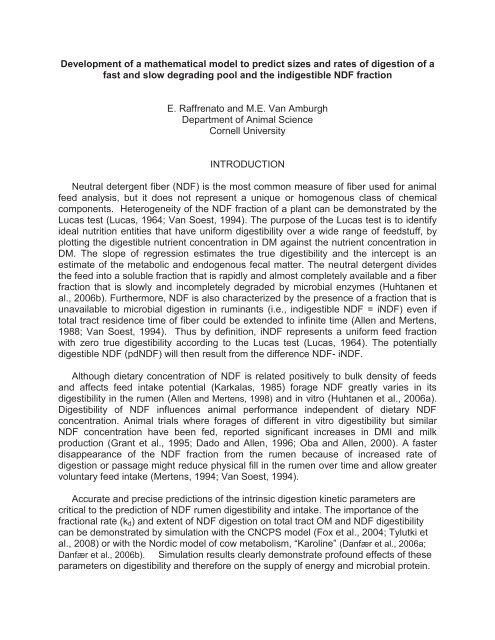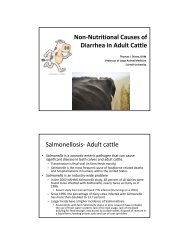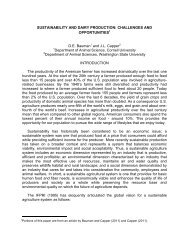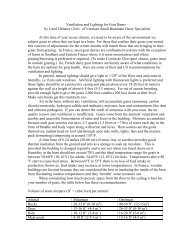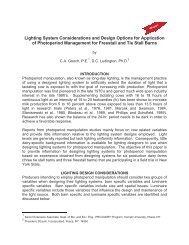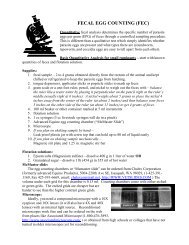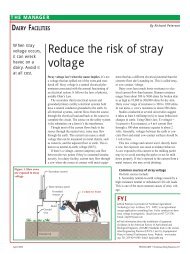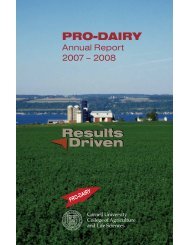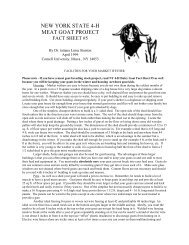Development of a mathematical model to predict sizes and rates of ...
Development of a mathematical model to predict sizes and rates of ...
Development of a mathematical model to predict sizes and rates of ...
Create successful ePaper yourself
Turn your PDF publications into a flip-book with our unique Google optimized e-Paper software.
<strong>Development</strong> <strong>of</strong> a <strong>mathematical</strong> <strong>model</strong> <strong>to</strong> <strong>predict</strong> <strong>sizes</strong> <strong>and</strong> <strong>rates</strong> <strong>of</strong> digestion <strong>of</strong> a<br />
fast <strong>and</strong> slow degrading pool <strong>and</strong> the indigestible NDF fraction<br />
E. Raffrena<strong>to</strong> <strong>and</strong> M.E. Van Amburgh<br />
Department <strong>of</strong> Animal Science<br />
Cornell University<br />
INTRODUCTION<br />
Neutral detergent fiber (NDF) is the most common measure <strong>of</strong> fiber used for animal<br />
feed analysis, but it does not represent a unique or homogenous class <strong>of</strong> chemical<br />
components. Heterogeneity <strong>of</strong> the NDF fraction <strong>of</strong> a plant can be demonstrated by the<br />
Lucas test (Lucas, 1964; Van Soest, 1994). The purpose <strong>of</strong> the Lucas test is <strong>to</strong> identify<br />
ideal nutrition entities that have uniform digestibility over a wide range <strong>of</strong> feedstuff, by<br />
plotting the digestible nutrient concentration in DM against the nutrient concentration in<br />
DM. The slope <strong>of</strong> regression estimates the true digestibility <strong>and</strong> the intercept is an<br />
estimate <strong>of</strong> the metabolic <strong>and</strong> endogenous fecal matter. The neutral detergent divides<br />
the feed in<strong>to</strong> a soluble fraction that is rapidly <strong>and</strong> almost completely available <strong>and</strong> a fiber<br />
fraction that is slowly <strong>and</strong> incompletely degraded by microbial enzymes (Huhtanen et<br />
al., 2006b). Furthermore, NDF is also characterized by the presence <strong>of</strong> a fraction that is<br />
unavailable <strong>to</strong> microbial digestion in ruminants (i.e., indigestible NDF = iNDF) even if<br />
<strong>to</strong>tal tract residence time <strong>of</strong> fiber could be extended <strong>to</strong> infinite time (Allen <strong>and</strong> Mertens,<br />
1988; Van Soest, 1994). Thus by definition, iNDF represents a uniform feed fraction<br />
with zero true digestibility according <strong>to</strong> the Lucas test (Lucas, 1964). The potentially<br />
digestible NDF (pdNDF) will then result from the difference NDF- iNDF.<br />
Although dietary concentration <strong>of</strong> NDF is related positively <strong>to</strong> bulk density <strong>of</strong> feeds<br />
<strong>and</strong> affects feed intake potential (Karkalas, 1985) forage NDF greatly varies in its<br />
digestibility in the rumen (Allen <strong>and</strong> Mertens, 1998) <strong>and</strong> in vitro (Huhtanen et al., 2006a).<br />
Digestibility <strong>of</strong> NDF influences animal performance independent <strong>of</strong> dietary NDF<br />
concentration. Animal trials where forages <strong>of</strong> different in vitro digestibility but similar<br />
NDF concentration have been fed, reported significant increases in DMI <strong>and</strong> milk<br />
production (Grant et al., 1995; Dado <strong>and</strong> Allen, 1996; Oba <strong>and</strong> Allen, 2000). A faster<br />
disappearance <strong>of</strong> the NDF fraction from the rumen because <strong>of</strong> increased rate <strong>of</strong><br />
digestion or passage might reduce physical fill in the rumen over time <strong>and</strong> allow greater<br />
voluntary feed intake (Mertens, 1994; Van Soest, 1994).<br />
Accurate <strong>and</strong> precise <strong>predict</strong>ions <strong>of</strong> the intrinsic digestion kinetic parameters are<br />
critical <strong>to</strong> the <strong>predict</strong>ion <strong>of</strong> NDF rumen digestibility <strong>and</strong> intake. The importance <strong>of</strong> the<br />
fractional rate (kd) <strong>and</strong> extent <strong>of</strong> NDF digestion on <strong>to</strong>tal tract OM <strong>and</strong> NDF digestibility<br />
can be demonstrated by simulation with the CNCPS <strong>model</strong> (Fox et al., 2004; Tylutki et<br />
al., 2008) or with the Nordic <strong>model</strong> <strong>of</strong> cow metabolism, “Karoline” (Danfær et al., 2006a;<br />
Danfær et al., 2006b). Simulation results clearly demonstrate pr<strong>of</strong>ound effects <strong>of</strong> these<br />
parameters on digestibility <strong>and</strong> therefore on the supply <strong>of</strong> energy <strong>and</strong> microbial protein.
Digestion <strong>rates</strong> can be highly variable between feeds <strong>and</strong> even within the same species<br />
(Van Soest, 1994).<br />
One <strong>of</strong> the main problems in describing digestion kinetics is that residues remaining<br />
at any digestion time are a mixture <strong>of</strong> undigested <strong>and</strong> indigestible matter (Mertens,<br />
1993). Furthermore, Mertens has indicated (Mertens, 1973; Mertens, 1977; Mertens<br />
<strong>and</strong> Ely, 1979) that overall digestion is better <strong>predict</strong>ed when assuming that the pdNDF<br />
fraction is the sum <strong>of</strong> two digestible fractions each <strong>of</strong> which are first order but with<br />
different rate constants. According <strong>to</strong> Van Milgen et al. (1991) the assumption <strong>of</strong> a<br />
single fractional digestion rate constant is also untenable because <strong>of</strong> the chemical <strong>and</strong><br />
morphological diversity <strong>of</strong> forages fed <strong>to</strong> lives<strong>to</strong>ck. More recently Ellis et al. (2005)<br />
demonstrated an improved fit <strong>of</strong> two-pool pdNDF <strong>model</strong>s that conformed <strong>to</strong><br />
expectations <strong>of</strong> a composite <strong>of</strong> lifetimes <strong>of</strong> two concurrently degrading sub-entities <strong>of</strong><br />
pdNDF with different degradation <strong>rates</strong>. Also for in-vitro gas production <strong>and</strong> NDF<br />
digestion, Huhtanen et al. (2008b) has recently shown a marked improvement <strong>of</strong> the<br />
<strong>model</strong> when pdNDF was assumed <strong>to</strong> be comprised <strong>of</strong> rapidly <strong>and</strong> slowly degradable<br />
fractions. Rate <strong>of</strong> digestion <strong>of</strong> NDF is an input in ration analyzers <strong>and</strong> <strong>model</strong>s (Fox et<br />
al., 2004; Tylutki et al, 2008). However, incorporation <strong>of</strong> digestion <strong>rates</strong> as a st<strong>and</strong>ard<br />
procedure <strong>to</strong> define the nutritive quality <strong>of</strong> specific feeds <strong>and</strong> diets has been achieved<br />
only recently, in part, because <strong>of</strong> lengthy labora<strong>to</strong>ry analyses <strong>and</strong> statistical<br />
interpretation <strong>of</strong> fiber digestion <strong>rates</strong>. The <strong>mathematical</strong> approach by Van Amburgh et<br />
al. (2004) described a method for determining <strong>rates</strong> <strong>of</strong> digestion for a single pool <strong>of</strong><br />
pdNDF with one time point assuming first order behavior <strong>and</strong> a fixed iNDF pool. The<br />
indigestible fraction was in that case estimated using the formula (ADL × 2.4)/NDF<br />
where the 2.4 was the fac<strong>to</strong>r obtained by Ch<strong>and</strong>ler et al. (1980).<br />
In a previous paper we demonstrated, through improved recoveries <strong>and</strong> definitions <strong>of</strong><br />
both ADL <strong>and</strong> iNDF (obtained after 240 hours <strong>of</strong> fermentation), the relationship between<br />
iNDF <strong>and</strong> ADL is more dynamic <strong>and</strong> can be <strong>predict</strong>ed using forage group-specific<br />
ranges (Raffrena<strong>to</strong> et al., 2009; Raffrena<strong>to</strong> et al., 2010; submitted) according <strong>to</strong> the<br />
ADL/NDF ratio <strong>of</strong> the specific forage. Our hypothesis is that the improved methodology<br />
for measuring ADL <strong>and</strong> the dynamic estimation <strong>of</strong> iNDF can result in a better description<br />
<strong>of</strong> pdNDF, with the least number <strong>of</strong> fermentation points. Therefore, our objective was <strong>to</strong><br />
describe fast <strong>and</strong> slow degrading pools <strong>of</strong> NDF, <strong>and</strong> the respective fractional digestion<br />
<strong>rates</strong> using 240 hours <strong>of</strong> fermentation as the endpoint for iNDF with a minimum <strong>of</strong> time<br />
points for application by commercial labora<strong>to</strong>ries. A secondary objective was <strong>to</strong> assess<br />
the accuracy <strong>and</strong> precision <strong>of</strong> <strong>predict</strong>ing the same parameters when an end point is not<br />
available <strong>and</strong> a forage-group-specific range for the ratio iNDF/(ADL/NDF), implemented<br />
as a proxy for iNDF was used instead. Finally, we wanted <strong>to</strong> demonstrate how a single<br />
weighted kd for the whole pdNDF fraction, from the fast <strong>and</strong> slow fractions, can be<br />
obtained <strong>and</strong> used when a fast <strong>and</strong> slow pool <strong>of</strong> NDF fermentation is not yet<br />
implemented in ration balancing s<strong>of</strong>tware. The approach used was <strong>to</strong> develop<br />
composite decay <strong>model</strong>s <strong>to</strong> describe the heterogeneous behavior <strong>of</strong> NDF digestion.<br />
Composite decay <strong>model</strong>s are formed by the sum <strong>of</strong> several exponential functions <strong>and</strong><br />
have been used <strong>to</strong> describe various physical phenomena <strong>and</strong> the non-linear least-
squares-fit is the most common method in use <strong>to</strong> solve them (Villuendas <strong>and</strong> Pelayo,<br />
1987).<br />
MATERIALS AND METHODS<br />
Thirty five forages, including grasses, conventional <strong>and</strong> bmr corn silages <strong>and</strong><br />
alfalfas, were analyzed in duplicates for NDF, ADL <strong>and</strong> 0.75 g <strong>of</strong> each sample<br />
fermented, <strong>and</strong> residues analyzed for NDF, from 0 <strong>to</strong> 240 hours according <strong>to</strong> Goering<br />
<strong>and</strong> Van Soest (1970). Rumen fluid was harvested from two cows being fed a TMR <strong>and</strong><br />
housed at the Cornell University research farm. Residual NDF <strong>of</strong> the fermented<br />
samples was obtained at 0, 6, 12, 24, 30, 36, 48, 72, 96, 120, 144, 216 <strong>and</strong> 240 hours<br />
based on the procedure <strong>of</strong> Mertens (2002). The samples that fermented longer than 120<br />
hours were re-inoculated at 120 hours with the same amount <strong>of</strong> the initial rumen<br />
liquor/medium mix. A glass micr<strong>of</strong>iber filter (934-AH, Whatman) was used in all<br />
analyses as suggested by Raffrena<strong>to</strong> <strong>and</strong> Van Amburgh (2010a <strong>and</strong> 2010b), <strong>to</strong> avoid<br />
particle loss <strong>and</strong> increase recovery. A composite decay <strong>model</strong> was used <strong>to</strong> estimate all<br />
parameters, pdNDF1, pdNDF2, <strong>and</strong> the respective fractional <strong>rates</strong> <strong>of</strong> digestion (kd1 <strong>and</strong><br />
kd2), <strong>and</strong> iNDF. Therefore the residual NDF at time t was described by:<br />
(1) NDFt = pdNDF1 * e -k1(t-L) + pdNDF2 * e -k2(t-L) + iNDF<br />
where pdNDF1, <strong>and</strong> k1 are the size <strong>and</strong> the fractional rate <strong>of</strong> the fast pool; pdNDF2,<br />
<strong>and</strong> k2 are the size <strong>and</strong> the fractional rate <strong>of</strong> the slow pool, respectively, L is the lag <strong>and</strong><br />
iNDF is the indigestible NDF. Simultaneous estimations <strong>of</strong> the parameters were initially<br />
obtained using PROC NLIN <strong>of</strong> SAS (SAS Institute, Inc., Cary, NC) <strong>and</strong> the Marquardt<br />
algorithm. Since non-linear regression methods assume equal error at each<br />
observation, simultaneously fitting all parameters <strong>to</strong> the data results in the smallest<br />
residual sums <strong>of</strong> squared deviations <strong>and</strong> no assumptions are required, thus they were<br />
chosen <strong>to</strong> be the st<strong>and</strong>ard procedure. For non-linear estimations, there are problems<br />
establishing the initial parameters, so a linear approach was used <strong>to</strong> seed the non-linear<br />
estimation as done by Grant <strong>and</strong> Mertens (1992). We used the log-linear approach <strong>of</strong><br />
Van Soest et al. (2005) <strong>to</strong> generate the initial values, for each sample, <strong>to</strong> parameterize<br />
the composite decay <strong>model</strong>, including a fast, a slow, <strong>and</strong> an indigestible pool for <strong>model</strong><br />
(1) described previously. This results in reasonable confidence that the global solution<br />
was obtained for each set <strong>of</strong> data. Furthermore, our <strong>mathematical</strong> approach described<br />
here is derived from the linearization <strong>of</strong> the non-linear first order composite decay <strong>and</strong> it<br />
therefore seems reasonable <strong>to</strong> make comparisons <strong>to</strong> this procedure <strong>and</strong> provides a<br />
simple cross-check <strong>of</strong> procedures.<br />
Assuming there is more than one fraction <strong>of</strong> pdNDF that can be described<br />
<strong>mathematical</strong>ly (Van Soest et al., 2005) a <strong>predict</strong>ion <strong>of</strong> three NDF fractions with the<br />
least possible number <strong>of</strong> fermentation points for use in commercial labora<strong>to</strong>ries was an<br />
objective. Vensim ® (Ventana Simulation Environment; Ventana Systems Inc., Belmont,<br />
MA, 2005) is a visual <strong>model</strong>ing <strong>to</strong>ol that allows the user <strong>to</strong> optimize <strong>model</strong>s with<br />
dynamic components or behavior. In our case, optimization can be used <strong>to</strong> validate<br />
parameters <strong>of</strong> a <strong>model</strong>. In order <strong>to</strong> use the optimization we need <strong>to</strong> define a “pay<strong>of</strong>f”,
which is a single number that summarizes the simulation, reported at the end <strong>of</strong> each<br />
simulation. In this procedure, an optimization was run using a different combination <strong>of</strong><br />
fermentation endpoints <strong>and</strong> the choice <strong>of</strong> the fermentation endpoints was made by<br />
evaluating the time points that best represented the three fractions with the least<br />
amount <strong>of</strong> error. Previous work by Van Soest et al. (2005) showed that the fast pool<br />
was exhausted by 48 hours, so the choice was made for a time point up <strong>to</strong> 48 hours <strong>to</strong><br />
represent the fast pool, a point between 48 <strong>and</strong> 216 <strong>to</strong> represent the slow pool, <strong>and</strong> the<br />
240 hours <strong>to</strong> represent the iNDF fraction. All combinations <strong>of</strong> the points available (6, 12,<br />
24, 30, 36 <strong>and</strong> 48 for the fast pool; 72, 96, 120, 144 <strong>and</strong> 216 for the slow pool) resulted<br />
in 30 possible combinations <strong>to</strong> be optimized.<br />
The <strong>model</strong> was defined in Vensim 5.5 (Ventana Simulation Environment; Ventana<br />
Systems Inc., Belmont, MA, 2005) <strong>and</strong> a modified Powell hill-climbing algorithm (Powell,<br />
1964) was used <strong>to</strong> perform the parameter optimization as defined in Vensim 5<br />
Reference Manual (Ventana Systems Inc., Belmont, MA, 2006). The pay<strong>of</strong>f for a <strong>model</strong><br />
can be defined in terms <strong>of</strong> comparison <strong>of</strong> <strong>model</strong> variables with actual data, or as<br />
combination <strong>of</strong> <strong>model</strong> variables. The residual NDF from zero <strong>to</strong> 240 hours was chosen<br />
as pay<strong>of</strong>f because this was the combination <strong>of</strong> all the parameters that need <strong>to</strong> be<br />
estimated (i.e.: pdNDF1, pdNDF2, k1, k2 <strong>and</strong> iNDF). The NDF residue at each<br />
fermentation time available (time step) from the data was subtracted from the<br />
corresponding value <strong>of</strong> the <strong>model</strong> at the same time step. The difference between the<br />
data <strong>and</strong> the <strong>model</strong> variable was then squared, <strong>and</strong> all values from all time points<br />
available were added. This number was then subtracted from the <strong>model</strong> pay<strong>of</strong>f.<br />
Maximizing the pay<strong>of</strong>f means reaching a value as close <strong>to</strong> zero for the squared<br />
difference. Constants <strong>of</strong> the <strong>model</strong> that were optimized for were: L, pdNDF1, pdNDF2,<br />
k1, k2, <strong>and</strong> iNDF, meaning the lag for the fast <strong>and</strong> the slow pool, the fast <strong>and</strong> slow pool<br />
<strong>and</strong> their <strong>rates</strong> <strong>and</strong> the indigestible fraction, respectively.<br />
For the non-linear optimization in Vensim, the iNDF was constrained <strong>to</strong> be between 0<br />
<strong>and</strong> the respective 240 hours NDF residual value. Lag was also constrained based on<br />
previous work from our labora<strong>to</strong>ry (Van Amburgh et al., 2004) <strong>and</strong> based on the results<br />
from the non-linear estimation in SAS (SAS Institute, Inc., Cary, NC). Based on our<br />
previous <strong>and</strong> contemporary work, L was constrained <strong>to</strong> be between 1.5 <strong>and</strong> 4.5 hours<br />
for all forage groups. The sum <strong>of</strong> the three pools was also constrained <strong>to</strong> be 1 <strong>to</strong> avoid<br />
negative results for the pools estimations.<br />
To determine the minimum number <strong>of</strong> values required from the fermentation <strong>to</strong><br />
establish the pool size <strong>and</strong> <strong>rates</strong>, constants were obtained from the optimization with<br />
Vensim <strong>and</strong> were then compared <strong>to</strong> the values obtained with the non-linear estimation<br />
from equation (1) from PROC NLIN in SAS (SAS Institute, Inc., Cary, NC). To evaluate<br />
the performance <strong>of</strong> the optimizations in Vensim, the goodness <strong>of</strong> fit was compared<br />
using the variance accounted for (R 2 ) <strong>and</strong> the residual mean squares (RMS) at<br />
convergence for ranking purposes, using the data pooling all forages analyzed <strong>and</strong> then<br />
by forage group, for each combination <strong>of</strong> time points, as in Ellis et al. (2005) <strong>and</strong><br />
Huhtanen et al. (2008). For each combination, the evaluation was then made separately<br />
for each parameter (pdNDF1, pdNDF2, k1, k2, L <strong>and</strong> iNDF) <strong>predict</strong>ed by the
optimization <strong>and</strong> computations were made as suggested by Piñeiro et al. (2008), with<br />
the non-linear estimation results considered the “observed” values. The root mean<br />
square error (RMSE) between the observed parameters <strong>and</strong> the <strong>predict</strong>ed values using<br />
the least number <strong>of</strong> fermentation endpoints, were calculated as follows: RMSE = √∑<br />
(observed – <strong>predict</strong>ed) 2 /n, where n is the number <strong>of</strong> forages. The mean square<br />
<strong>predict</strong>ion error (MSPE) was divided in<strong>to</strong> components resulting from mean bias, slope<br />
bias, <strong>and</strong> r<strong>and</strong>om or unexplained variation around the regression line according <strong>to</strong><br />
analysis <strong>of</strong> Theil (1966) <strong>and</strong> Bibby <strong>and</strong> Toutenburg (1977). Significance <strong>of</strong> the deviation<br />
<strong>of</strong> the intercept from 0 <strong>and</strong> the slope from 1 was analyzed by t-test. The same<br />
evaluation was made by forage group <strong>to</strong> highlight possible dynamic behavior <strong>of</strong> pools<br />
<strong>and</strong> <strong>rates</strong> across forage groups.<br />
Finally, <strong>to</strong> make this approach applicable <strong>to</strong> commercial labora<strong>to</strong>ries, an analyses<br />
<strong>and</strong> estimation <strong>of</strong> extent <strong>of</strong> NDF digestion <strong>and</strong> iNDF was conducted using forage-family<br />
specific endpoints for iNDF as a starting point, knowing there is a range within the iNDF<br />
value within <strong>and</strong> among forage families <strong>and</strong> there is a possibility that a labora<strong>to</strong>ry might<br />
not have 240 iNDF values. Therefore, assuming that the residue at 240 hours<br />
represents the true iNDF fraction, we defined specific ranges <strong>of</strong> the ratios<br />
iNDF/(ADL/NDF) for each forage group (conventional <strong>and</strong> bmr corn silages, alfalfas <strong>and</strong><br />
grasses) <strong>and</strong> determined the range <strong>and</strong> variance associated with the iNDF value within<br />
our dataset. The same evaluation described above was then performed using these<br />
specific ranges <strong>to</strong> determine the absolute minimum <strong>of</strong> points needed <strong>to</strong> estimate pdNDF<br />
<strong>and</strong> kd. The iNDF was in then constrained <strong>to</strong> fall within the range defined for each<br />
forage group, based on the ADL/NDF ratio. The ratios iNDF/(ADL/NDF) were<br />
constrained in the following manner: 3.0-5.5 for conventional corn silages, 2.0-6.0 for<br />
bmr corn silages, 2.0-7.0 for grasses, 2.0-5.0 for straws <strong>and</strong> hays <strong>and</strong> 2.0-3.0 for<br />
alfalfas (Raffrena<strong>to</strong> <strong>and</strong> Van Amburgh, submitted). The other constraints were as<br />
previously described. Goodness <strong>of</strong> fit was evaluated as mentioned previously, using<br />
the 240 hours as the observed iNDF.<br />
RESULTS AND DISCUSSION<br />
Descriptive values <strong>of</strong> the forages by group are found in Table 1. The non-linear<br />
<strong>model</strong> resulted in a high R 2 (>0.98) for all forages. Average values <strong>of</strong> pools <strong>sizes</strong> <strong>and</strong><br />
fractional <strong>rates</strong> obtained from the non-linear estimation are shown in Table 2 (“observed<br />
values”). A rate <strong>of</strong> digestion developed from the weighted average <strong>of</strong> the pdNDF was<br />
obtained. The pools <strong>sizes</strong> <strong>and</strong> <strong>rates</strong> obtained from the non-linear estimation (Table 2)<br />
allowed the extrapolation <strong>of</strong> the residual pools (example in Figure 1) for the whole curve<br />
<strong>and</strong> it was observed that residues <strong>of</strong> pdNDF1 became in most cases negative at 48<br />
hours <strong>and</strong> always at 72 hours, meaning that the fast pool (pdNDF1) was exhausted<br />
between 48 <strong>and</strong> 72 hours for all forages analyzed, confirming the previous data (Van<br />
Soest et al., 2005). Forages such as bmr corn silages <strong>and</strong> alfalfas exhausted their fast<br />
pool earlier (36 <strong>to</strong> 48 hours) in the fermentation curve, when compared <strong>to</strong> conventional<br />
corn silages <strong>and</strong> grasses.
The R 2 <strong>and</strong> the RMS among forages resulted each in one value for each forage <strong>and</strong><br />
combination <strong>of</strong> time points. For ranking purposes we used the average values among all<br />
forages, within each time point combination. This resulted in a ranking <strong>of</strong> goodness <strong>of</strong> fit<br />
<strong>of</strong> all possible combinations from Vensim, when pooling all forages. The best<br />
combinations were found <strong>to</strong> be from the following time points: 36-120, 48-120 <strong>and</strong> 48-96<br />
hours. Although these combinations ranked the highest in order <strong>of</strong> goodness <strong>of</strong> fit, there<br />
were small differences in RMSE <strong>and</strong> MSPE, thus a decision was made <strong>to</strong> use only the<br />
36 <strong>and</strong> 120 hours time step since that combination resulted in the best average R 2 <strong>and</strong><br />
RMS. For this specific combination, the R 2 obtained regressing observed on <strong>predict</strong>ed<br />
parameters, ranged between 0.77 <strong>and</strong> 0.98, among all the parameters, except for the<br />
lag. Other combinations will be addressed on a forage specific basis later in the paper.<br />
Table 1. Neutral detergent fiber (NDF) (% <strong>of</strong> DM), acid detergent lignin (ADL, g/kg<br />
NDF), indigestible NDF (iNDF, g/kg NDF) <strong>and</strong> calculated ratios <strong>of</strong><br />
iNDF/(ADL/NDF) <strong>and</strong> respective ranges <strong>of</strong> the forages used in the analyses per<br />
group <strong>of</strong> conventional <strong>and</strong> bmr corn silages (C.S.), grasses <strong>and</strong> alfalfas(ranges in<br />
parentheses).<br />
Group n NDF ADL iNDF ratio<br />
% <strong>of</strong> DM -----g/kg NDF------<br />
Conventional C.S. 7 44.04 68.6 232.4 3.38 (3.23-5.46)<br />
BMR C.S. 6 39.06 34.2 123.2 3.60 (2.14-5.78)<br />
Grasses 6 64.03 80.9 286.3 3.53 (2.59-6.53)<br />
Straws <strong>and</strong> hays 4 77.25 90.0 343.2 3.45 (2.60-4.39)<br />
Alfalfas 7 36.64 169.1 428.2 2.53 (2.43-2.95)<br />
Table 2: Pools <strong>sizes</strong> <strong>and</strong> <strong>rates</strong> obtained from the simultaneous non-linear estimation<br />
using equation (1) <strong>and</strong> the non-linear procedure in SAS, averaged by forage<br />
group. The pdNDF1 represents the percentage <strong>of</strong> NDF in the potentially<br />
digestible NDF pool 1, pdNDF2 is the percentage <strong>of</strong> NDF in the potentially<br />
digestible NDF pool 2 <strong>and</strong> the k1 <strong>and</strong> k2 are the associated <strong>rates</strong>. The kd<br />
represents a weighted average rate <strong>of</strong> pdNDF1 <strong>and</strong> pdNDF2.<br />
Group n pdNDF1 pdNDF2 iNDF k1 k2 kd<br />
-----------% <strong>of</strong> NDF--------- -----------------%/h---------------<br />
Conventional C.S. 7 60.66 18.71 20.63 0.0729 0.0162 0.0597<br />
BMR C.S. 6 73.76 13.14 13.11 0.0873 0.0239 0.0781<br />
Grasses 6 54.45 24.45 21.10 0.0941 0.0162 0.0669<br />
Straws <strong>and</strong> hays 4 58.68 10.35 32.27 0.0399 0.0069 0.0351<br />
Alfalfas 7 48.75 8.73 42.53 0.1344 0.0238 0.1128
Figure 1: Residual NDF during the in-vitro fermentation, from 0 <strong>to</strong> 240 hours, <strong>and</strong> the<br />
extrapolated amounts <strong>of</strong> the fast (P1) <strong>and</strong> the slow pool (P2) for a<br />
conventional corn silage.<br />
NDF residue<br />
Figure 2: Average distribution <strong>of</strong> fast <strong>and</strong> slow pool <strong>and</strong> indigestible fractions in the<br />
forages analyzed, averaged by forage group. Numbers within pools represent<br />
the respective average fractional <strong>rates</strong> (1/h).<br />
100%<br />
90%<br />
80%<br />
70%<br />
60%<br />
50%<br />
40%<br />
30%<br />
20%<br />
10%<br />
0%<br />
1.000<br />
0.800<br />
0.600<br />
0.400<br />
0.200<br />
0.000<br />
0 50 100 150 200 250<br />
time, hrs<br />
0.073 0.087 0.094 0.039 0.013<br />
0.016<br />
0.024<br />
0.016<br />
0.007<br />
Conv. CS Bmr CS Grasses Straws/Hays Alfalfas<br />
Using 36 <strong>and</strong> 120 hours time points <strong>and</strong> the measured iNDF fraction provided the<br />
highest correlations between the optimization in Vensim <strong>and</strong> the values from the nonlinear<br />
estimation (P < 0.01), with ranges in correlation between 0.88 <strong>and</strong> 0.99.<br />
However, even if the overall equations tended <strong>to</strong> describe the data equally well, our<br />
objective was the development <strong>of</strong> a <strong>mathematical</strong> approach that would allow a<br />
P1<br />
P2<br />
0.024<br />
P1+P2+iNDF<br />
<strong>and</strong><br />
pdNDF1<br />
pdNDF2<br />
iNDF
commercial forage labora<strong>to</strong>ry <strong>to</strong> generate this data for field application, therefore the<br />
analysis <strong>of</strong> the bias in the actual values <strong>of</strong> the parameters obtained due <strong>to</strong> calculation<br />
method was important. Pools <strong>sizes</strong> <strong>and</strong> <strong>rates</strong> <strong>of</strong> digestion were evaluated for their<br />
<strong>predict</strong>ion accuracy <strong>and</strong> biological relevance, with the preferred <strong>predict</strong>ion having a<br />
small regression bias <strong>and</strong> minimal unexplained variation.<br />
In our current approach, the <strong>predict</strong>ion <strong>of</strong> the lag resulted in very low correlation with<br />
the observed values (P < 0.05), a consistently high RMSE (>50%) <strong>and</strong> the <strong>predict</strong>ion is<br />
omitted from the tables. This was most likely due <strong>to</strong> the lack <strong>of</strong> time points early enough<br />
in the fermentation <strong>to</strong> allow the optimizer <strong>to</strong> estimate the lag. However, results show that<br />
the lag does not affect the <strong>predict</strong>ion <strong>of</strong> the pool size parameters, if the lag is<br />
constrained within a reasonable range <strong>of</strong> observed values during the optimization<br />
(Raffrena<strong>to</strong> et al., 2009). In our labora<strong>to</strong>ry procedure, the lag is generally less than 3<br />
hours <strong>and</strong> can average less than 1.5 hours depending on the forage <strong>and</strong> rate <strong>of</strong><br />
hydration at inoculation. The <strong>predict</strong>ion <strong>of</strong> the pool <strong>sizes</strong> resulted in RMSE lower than<br />
5% <strong>of</strong> the <strong>to</strong>tal NDF pool size. In addition, the <strong>predict</strong>ion <strong>of</strong> the <strong>rates</strong> resulted in RMSE<br />
lower than 0.5% <strong>of</strong> k1 <strong>and</strong> k2. Finally, the <strong>predict</strong>ion <strong>of</strong> the iNDF was characterized by<br />
a very low RMSE, (1.4% <strong>of</strong> the <strong>to</strong>tal NDF pool), confirming that the 240 hours NDF<br />
residual represents the true indigestible fraction.<br />
The relationships among the <strong>predict</strong>ed <strong>and</strong> observed parameter values for the 36-<br />
120 hour time points are shown in Table 3. All R 2 were consistently higher than 0.77.<br />
The optimizations slightly over-<strong>predict</strong>ed the size <strong>of</strong> pdNDF1, however slopes were not<br />
statistically different from 1 (P > 0.05). In most cases the r<strong>and</strong>om variation had the<br />
greatest contribution <strong>to</strong> the <strong>to</strong>tal MSPE, especially for pool size <strong>predict</strong>ions.<br />
To test the effect <strong>of</strong> not using the measured iNDF, the optimizer was constrained <strong>to</strong><br />
forage-group-specific ranges for iNDF <strong>and</strong> this procedure resulted in an overall lower<br />
RMS <strong>and</strong> higher R 2 for the 30-120 hours combination. Under these conditions, the 36<br />
hour time point did not provide the best solution. The outcome demonstrated that he<br />
indigestible portion was efficiently estimated, <strong>and</strong> the optimization was able <strong>to</strong> explain<br />
97% <strong>of</strong> the variation in iNDF (Table 4). A gain, RMSE <strong>and</strong> MSPE values were mainly<br />
the result <strong>of</strong> unexplained variation. This suggests that once we underst<strong>and</strong> the range in<br />
iNDF within a forage type, we can estimate the iNDF through non-linear approaches<br />
<strong>and</strong> that would preclude the need <strong>to</strong> conduct the long-term fermentations. However, we<br />
are going <strong>to</strong> strongly suggest that a large data set <strong>of</strong> 240 hr fermentations are needed <strong>to</strong><br />
truly establish the relationships <strong>and</strong> then an NIR approach can be used.<br />
Again, the optimization <strong>of</strong> the lag values resulted in the lowest correlations, <strong>and</strong> the<br />
highest values <strong>of</strong> MSPE <strong>and</strong> RMSE indicating a lack <strong>of</strong> information for the optimization.<br />
As previously shown (Raffrena<strong>to</strong> et al., 2009), the estimation <strong>of</strong> iNDF was therefore<br />
more important than the estimation <strong>of</strong> the lag in the <strong>predict</strong>ion <strong>of</strong> the other parameters <strong>of</strong><br />
a decay <strong>model</strong>. All other parameters resulted in very low bias, slope <strong>and</strong> r<strong>and</strong>om<br />
variation <strong>and</strong> the optimization in Vensim can become a routine <strong>to</strong>ol <strong>to</strong> better define fiber<br />
fractions in forages for a better decision making process for nutritionists.
Table 3: Relationship between the <strong>predict</strong>ed <strong>and</strong> observed <strong>model</strong> parameters when<br />
using 36 <strong>and</strong> 120 hours as fermentation time points <strong>and</strong> pooling all forages.<br />
Parameter Intercept Slope R 2<br />
pdNDF1 0.1199 0.8483 0.83<br />
pdNDF2 0.0108 0.7499 0.84<br />
k1 0.0022 0.9240 0.87<br />
k2 0.0009 0.7551 0.77<br />
iNDF -0.0128 1.0228 0.98<br />
a : Intercept significantly (P < 0.05) different from 0.<br />
b : Slope significantly (P < 0.05) different from 1.<br />
Table 4: Relationship between the <strong>predict</strong>ed <strong>and</strong> observed <strong>model</strong> parameters when<br />
using 30 <strong>and</strong> 120 hours as fermentation time points, <strong>and</strong> constraining iNDF <strong>to</strong><br />
forage-family-specific ranges, when pooling all forages <strong>and</strong> not using the<br />
measured iNDF.<br />
Parameter Intercept Slope R 2<br />
pdNDF1 0.0944 0.8562 0.77<br />
pdNDF2 0.0098 0.8445 0.73<br />
k1 0.0101 0.9010 0.76<br />
k2 0.0023 0.8485 0.75<br />
iNDF 0.0157 0.9590 0.97<br />
After evaluating the global data set, it became apparent that due <strong>to</strong> the more<br />
dynamic nature <strong>of</strong> the iNDF <strong>and</strong> the apparent differences in the size <strong>and</strong> rate <strong>of</strong> the<br />
pdNDF1 pool, it would be more efficient <strong>and</strong> practical <strong>to</strong> run forage specific solutions.<br />
Therefore, we optimized all the same combinations <strong>of</strong> time points for the corn silages as<br />
an example <strong>of</strong> the improvements in efficiency <strong>and</strong> accuracy that could be obtained. We<br />
recognize the small data set, but the solutions appear <strong>to</strong> be very robust. Using the<br />
same evaluation for goodness <strong>of</strong> fit, the results clearly demonstrated that different time<br />
points might be necessary <strong>to</strong> reach the “best possible estimation” <strong>of</strong> pools <strong>and</strong> <strong>rates</strong> for<br />
a specific forage group. The relationship between <strong>predict</strong>ed <strong>and</strong> observed values was<br />
quite good, with intercepts not different than zero <strong>and</strong> slopes not different than one<br />
(Table 5). Specifically, conventional corn silages showed the lowest RMS <strong>and</strong> highest<br />
R 2 for the 36-120 hours combination (with similar values for the 48-120 hours), when<br />
using 240 hours for iNDF. The parameter <strong>predict</strong>ion was better when conducted on an<br />
individual forage family basis than when pooling all forages among groups, with lower<br />
RMSE <strong>and</strong> MSPE <strong>and</strong> higher R 2 .
Table 5: Relationship between the <strong>predict</strong>ed <strong>and</strong> observed <strong>model</strong> parameters when<br />
using 36 <strong>and</strong> 120 hours <strong>and</strong> the measured iNDF (240 hours) as fermentation<br />
time points for conventional corn silages.<br />
Parameter Intercept Slope R 2<br />
pdNDF1 0.0399 0.9213 0.91<br />
pdNDF2 0.0208 0.8563 0.88<br />
K1 0.0032 1.0112 0.89<br />
K2 0.0019 0.9653 0.81<br />
iNDF 0.0019 0.9865 0.98<br />
Constraining the optimizer <strong>to</strong> the range for iNDF specific for conventional corn silages<br />
<strong>and</strong> not including the 240 hours as time point, resulted in overall lower RMS <strong>and</strong> higher<br />
R 2 for the 36-120 hours combination (Table 6). There was an improvement in the slope<br />
<strong>and</strong> intercept parameters compared <strong>to</strong> pooling all forages <strong>and</strong> the iNDF was again<br />
efficiently estimated. The optimization was able <strong>to</strong> explain 98% <strong>of</strong> the variation in iNDF<br />
using the ranges <strong>to</strong> seed the non-linear process <strong>and</strong> the RMSE <strong>and</strong> MSPE values were<br />
primarily result <strong>of</strong> unexplained variation.<br />
Other forage groups are not shown, however overall results show 36 (or 48) <strong>and</strong> 120<br />
hours being the optimal combination <strong>of</strong> time points. Both bmr corn silages <strong>and</strong> alfalfas<br />
resulted in better goodness <strong>of</strong> fit when using 24-96 hours <strong>and</strong> 30-120 hours,<br />
respectively most likely because <strong>of</strong> the time point where the pdNDF1 is exhausted.<br />
Grass hays <strong>and</strong> straws instead resulted in better estimations <strong>of</strong> pools <strong>and</strong> <strong>rates</strong> when<br />
residual at 36-96 or 48-96 hours were used for the optimization, respectively. The<br />
<strong>predict</strong>ion results appear <strong>to</strong> be dependent on when the fast pool is exhausted. More<br />
forage analyses will be necessary <strong>to</strong> confirm this concept <strong>and</strong> <strong>to</strong> better explain the<br />
variation within forage group.<br />
The calculation <strong>of</strong> k1 <strong>and</strong> k2 using the Vensim optimization has the advantage <strong>of</strong><br />
requiring the least amount <strong>of</strong> fermentation information that could be generated by<br />
commercial labora<strong>to</strong>ries. Since the calculations are direct <strong>and</strong> use no statistical<br />
regression procedures, they are simpler <strong>to</strong> implement because many observations are<br />
not required. If a number <strong>of</strong> time point digestions are available, means <strong>and</strong> st<strong>and</strong>ard<br />
deviations <strong>of</strong> the respective lag <strong>and</strong> rate values can be calculated <strong>and</strong> their uniformity<br />
examined. An improvement <strong>of</strong> the lag estimation is possible using another time-point in<br />
early fermentation, <strong>to</strong> be used in the Vensim optimization as was done in the work by<br />
Van Amburgh et al. (2003). However the average value <strong>of</strong> the lag estimated by the non-
Table 6: Relationship between the <strong>predict</strong>ed <strong>and</strong> observed <strong>model</strong> parameters when<br />
using 36 <strong>and</strong> 120 hours as fermentation time points, <strong>and</strong> constraining iNDF <strong>to</strong><br />
forage-family-specific ranges, when pooling all forages.<br />
Parameter Intercept Slope R 2<br />
pdNDF1 0.0532 0.9312 0.79<br />
pdNDF2 0.0122 0.8923 0.75<br />
k1 0.0098 0.9101 0.79<br />
k2 0.0032 0.8332 0.75<br />
iNDF 0.0034 1.0012 0.98<br />
linear composite decay, per group, was between 1.7 <strong>and</strong> 3.1 hours, with the lowest<br />
values for alfalfas <strong>and</strong> the highest values for straws <strong>and</strong> hays, respectively.<br />
Constraining the lag <strong>to</strong> be the average per forage group during the optimization will<br />
improve the optimization. Ranges can however vary within <strong>and</strong> among labora<strong>to</strong>ries,<br />
depending on the in-vitro procedure <strong>and</strong> rumen fluid h<strong>and</strong>ling. However, the results<br />
show that an unknown lag (within the normal range) will not bias the final estimation <strong>of</strong><br />
pools <strong>sizes</strong> <strong>and</strong> <strong>rates</strong>.<br />
According <strong>to</strong> Ellis et al. (1999) determination <strong>of</strong> iNDF should be included in all basic<br />
feedstuff analysis because it has a <strong>predict</strong>able digestibility; it can be used for the<br />
estimation <strong>of</strong> the pdNDF as NDF-iNDF <strong>and</strong> it has an important role in contributing <strong>to</strong><br />
rumen digesta load. Furthermore, a close empirical relationship between silage iNDF<br />
<strong>and</strong> OM digestibility (Nousiainen et al., 2003) indicates that iNDF is a useful entity for<br />
the <strong>predict</strong>ion <strong>of</strong> the nutritive value <strong>of</strong> forages. We demonstrated that <strong>predict</strong>ion <strong>of</strong> the<br />
indigestible fraction is possible if longer time points are not available, by using foragegroup<br />
specific ratios <strong>of</strong> iNDF/(ADL/NDF) (Tables 4 <strong>and</strong> 6). However, better results will<br />
be guaranteed by longer fermentations (up <strong>to</strong> 240 hours) <strong>to</strong> estimate the indigestible<br />
fraction. A larger data set <strong>of</strong> long-term fermentations (240 hours) with intermediate time<br />
points are needed <strong>to</strong> build a data set able <strong>to</strong> explain the variation in NDF pool size <strong>and</strong><br />
within forage group <strong>and</strong> this should be linked <strong>to</strong> the agronomic conditions the plants<br />
were grown under.<br />
SUMMARY<br />
� NDF is confirmed <strong>to</strong> be a non-uniform fraction with multiple pools.<br />
� Later points in the fermentation curve, even if not biologically relevant for the<br />
cow, explain the non-uniformity <strong>and</strong> result in a more accurate <strong>and</strong> precise single<br />
weighted rate <strong>of</strong> NDF digestibility.<br />
� The fast, slow <strong>and</strong> indigestible pools <strong>and</strong> respective <strong>rates</strong> can be estimated using<br />
a minimum <strong>of</strong> time points <strong>of</strong> in vitro NDFD data <strong>and</strong> a forage-group specific ratio<br />
iNDF/(ADL/NDF) <strong>to</strong> obtain the indigestible portion.
� Measures <strong>of</strong> pools <strong>and</strong> <strong>rates</strong> can be used <strong>to</strong> help explain cow intake behavior or<br />
<strong>to</strong> compare forages, especially when chemical analyses show forages <strong>to</strong> be<br />
similar.<br />
� Estimations <strong>of</strong> the slow pool <strong>and</strong> its rate along with the size <strong>of</strong> the iNDF fraction<br />
can theoretically be linked <strong>to</strong> effects on dry matter intake <strong>and</strong> passage by<br />
increasing the bulk <strong>of</strong> the diet (rumen load).<br />
REFERENCES<br />
Allen, M. S. <strong>and</strong> D. R. Mertens. 1988. Evaluating constraints on fiber digestion by rumen<br />
microbes. J. Nutr. 118:261-270.<br />
Bibby, J. <strong>and</strong> H. Toutenburg. 1977. Prediction <strong>and</strong> Improved Estimation in Linear<br />
Models. Wiley New York, .<br />
Ch<strong>and</strong>ler, J. A., W. J. Jewell, J. M. Gossett, P. J. Van soest <strong>and</strong> J. B. Robertson. 1980.<br />
Predicting methane fermentation biodegradability. Biotechnology <strong>and</strong><br />
Bioengineering Symp. 10:93-107.<br />
Dado, R. G. <strong>and</strong> M. S. Allen. 1996. Enhanced intake <strong>and</strong> production <strong>of</strong> cows <strong>of</strong>fered<br />
ensiled alfalfa with higher neutral detergent fiber digestibility. J. Dairy Sci.<br />
79:418-428.<br />
Danfær, A., P. Huhtanen, P. Udén, J. Sveinbjörnsson, H. Volden, E. Kebreab, J.<br />
Dijkstra, A. Bannink, W. J. J. Gerrits <strong>and</strong> J. France. 2006a. The nordic dairy cow<br />
<strong>model</strong>, Karoline–description. Nutrient Digestion <strong>and</strong> Utilization in Farm Animals:<br />
Modelling Approaches. 383.<br />
Danfær, A., P. Huhtanen, P. Udén, J. Sveinbjörnsson, H. Volden, E. Kebreab, J.<br />
Dijkstra, A. Bannink, W. J. J. Gerrits <strong>and</strong> J. France. 2006b. The nordic dairy cow<br />
<strong>model</strong>, Karoline–Evaluation. Nutrient Digestion <strong>and</strong> Utilization in Farm Animals:<br />
Modelling Approaches. 407.<br />
Ellis, W. C., M. Mahlooji <strong>and</strong> J. H. Matis. 2005. Models for estimating parameters <strong>of</strong><br />
neutral detergent fiber digestion by ruminal microorganisms. J. Anim. Sci.<br />
83:1591.<br />
Ellis, W. C., D. P. Poppi, J. H. Matis, H. Lippke, T. M. Hill <strong>and</strong> F. M. Roquette. 1999.<br />
Dietary-digestive-metabolic interactions determining the nutritive potential <strong>of</strong><br />
ruminant diets. Nutritional Ecology <strong>of</strong> Herbivores. 423-481.<br />
Fox, D. G., L. O. Tedeschi, T. P. Tylutki, J. B. Russell, M. E. Van Amburgh, L. E. Chase,<br />
A. N. Pell <strong>and</strong> T. R. Over<strong>to</strong>n. 2004. The cornell net carbohydrate <strong>and</strong> protein<br />
system <strong>model</strong> for evaluating herd nutrition <strong>and</strong> nutrient excretion. Anim. Feed<br />
Sci. Technol. 112:29-78.<br />
Goering, H. K. <strong>and</strong> P. J. Van Soest. 1970. Forage Fiber Analyses (Apparatus,<br />
Reagents, Procedures, <strong>and</strong> some Applications). US Agricultural Research<br />
Service, .<br />
Grant, R. J., S. G. Haddad, K. J. Moore <strong>and</strong> J. F. Pedersen. 1995. Brown midrib<br />
sorghum silage for midlactation dairy cows. J. Dairy Sci. 78:1970-1980.<br />
Grant R.J. <strong>and</strong> D.R. Mertens. 1992. Influence <strong>of</strong> buffer pH <strong>and</strong> raw corn starch addition<br />
on in vitro fiber digestion kinetics. J. Dairy Sci. 75:2762–2768
Huhtanen, P., S. Ahvenjärvi, M. R. Weisbjerg <strong>and</strong> P. Nørgaard. 2006a. Digestion <strong>and</strong><br />
passage <strong>of</strong> fibre in ruminants. Ruminant Physiology: Digestion, Metabolism <strong>and</strong><br />
Impact <strong>of</strong> Nutrition on Gene Expression, Immunology <strong>and</strong> Stress. 87.<br />
Huhtanen, P., J. Nousiainen <strong>and</strong> M. Rinne. 2006b. Recent developments in forage<br />
evaluation with special reference <strong>to</strong> practical applications. Agricultural <strong>and</strong> Food<br />
Science. 15:293-323.<br />
Huhtanen, P., A. Seppala, S. Ahvenjarvi <strong>and</strong> M. Rinne. 2008a. Prediction <strong>of</strong> in vivo NDF<br />
digestibility <strong>and</strong> digestion rate <strong>of</strong> potentially digestible NDF: Comparison <strong>of</strong><br />
<strong>model</strong>s. J. Anim. Sci.<br />
Huhtanen, P., A. Seppala, M. Ots, S. Ahvenjarvi <strong>and</strong> M. Rinne. 2008b. In vitro gas<br />
production pr<strong>of</strong>iles <strong>to</strong> estimate extent <strong>and</strong> effective first-order rate <strong>of</strong> neutral<br />
detergent fiber digestion in the rumen. J. Anim. Sci. 86:651.<br />
Karkalas, J. 1985. An improved enzymatic method for the determination <strong>of</strong> native <strong>and</strong><br />
modified starch. J. Sci. Food Agric. 36:1019-1027.<br />
Lucas, H. L. 1964. S<strong>to</strong>chastic elements in biological <strong>model</strong>s; their sources <strong>and</strong><br />
significance. S<strong>to</strong>chastic Models in Medicine <strong>and</strong> Biology. J. Gurl<strong>and</strong>, Ed. Univ.<br />
Wisconsin Press, Madison. 355-383.<br />
Mertens, D. R. 1993. Rate <strong>and</strong> extent <strong>of</strong> digestion. Quantitative Aspects <strong>of</strong> Ruminant<br />
Digestion <strong>and</strong> Metabolism. 13–51.<br />
Mertens, D. R. 1973. Application <strong>of</strong> theoretical <strong>mathematical</strong> <strong>model</strong>s <strong>to</strong> cell wall<br />
digestion <strong>and</strong> forage intake in ruminants. Ph.D. Dissertation. Cornell University,<br />
Ithaca, NY<br />
Mertens, D. R. <strong>and</strong> L. O. Ely. 1979. A dynamic <strong>model</strong> <strong>of</strong> fiber digestion <strong>and</strong> passage in<br />
the ruminant for evaluating forage quality. J. Anim. Sci. 49:1085.<br />
Mertens, D. R. 2002. Gravimetric determination <strong>of</strong> amylase-treated neutral detergent<br />
fiber in feeds with refluxing in beakers or crucibles: Collaborative study. J. AOAC<br />
Int. 85:1217-1240.<br />
Mertens, D. R. 1977. Dietary fiber components: Relationship <strong>to</strong> the rate <strong>and</strong> extent <strong>of</strong><br />
ruminal digestion. Fed. Proc. 36:187-192.<br />
Nousiainen, J., M. Rinne, M. Hellämäki <strong>and</strong> P. Huhtanen. 2003. Prediction <strong>of</strong> the<br />
digestibility <strong>of</strong> the primary growth <strong>of</strong> grass silages harvested at different stages <strong>of</strong><br />
maturity from chemical composition <strong>and</strong> pepsin-cellulase solubility. Anim. Feed<br />
Sci. Technol. 103:97-111.<br />
Oba, M. <strong>and</strong> M. S. Allen. 2000. Effects <strong>of</strong> brown midrib 3 mutation in corn silage on<br />
productivity <strong>of</strong> dairy cows fed two concentrations <strong>of</strong> dietary neutral detergent<br />
fiber: 1. feeding behavior <strong>and</strong> nutrient utilization. J. Dairy Sci. 83:1333-1341.<br />
Piñeiro, G., S. Perelman, J. P. Guerschman <strong>and</strong> J. M. Paruelo. 2008. How <strong>to</strong> evaluate<br />
<strong>model</strong>s: Observed vs. <strong>predict</strong>ed or <strong>predict</strong>ed vs. observed? Ecol. Model.<br />
216:316-322.<br />
Powell, M. J. D. 1964. An efficient method for finding the minimum <strong>of</strong> a function <strong>of</strong><br />
several variables without calculating derivatives. The Computer Journal. 7:155.<br />
Raffrena<strong>to</strong>, E., R. Fievisohn, K. W. Cotanch, R. J. Grant, P. J. Van Soest, L. E. Chase<br />
<strong>and</strong> M. E. Van Amburgh. 2009. ANDF, NDFD, INDF, ADL <strong>and</strong> kd: What have we<br />
learned? Page 77 in Cornell nutrition conference for feed manufacturers, .<br />
Theil, H. 1966. Applied Economic Forecasting. Chicago: R<strong>and</strong> McNall. Amsterdam, .
Tylutki, T. P., D. G. Fox, V. M. Durbal, L. O. Tedeschi, J. B. Russell, M. E. Van<br />
Amburgh, T. R. Over<strong>to</strong>n, L. E. Chase <strong>and</strong> A. N. Pell. 2008. Cornell net<br />
carbohydrate <strong>and</strong> protein system: A <strong>model</strong> for precision feeding <strong>of</strong> dairy cattle.<br />
Anim. Feed Sci. Technol. 143:174-202.<br />
Van Amburgh, M. E., P. J. Van Soest, J. B. Robertson <strong>and</strong> W. F. Knaus. 2003. Corn<br />
silage neutral detergent fiber: Refining a <strong>mathematical</strong> approach for in vitro <strong>rates</strong><br />
<strong>of</strong> digestion. Pp. 99-108. Proc. Cornell Nutr. Conf., Syracuse, NY.<br />
Van Milgen, J., M. R. Murphy <strong>and</strong> L. L. Berger. 1991a. A compartmental <strong>model</strong> <strong>to</strong><br />
analyze ruminal digestion. J. Dairy Sci. 74:2515-2529.<br />
Van Soest, P. J. 1994. Nutritional Ecology <strong>of</strong> the Ruminant. Cornell Univ Press, Ithaca,<br />
NY .<br />
Van Soest, P. J., M. E. Van Amburgh, J. B. Robertson <strong>and</strong> W. F. Knaus. 2005.<br />
Validation <strong>of</strong> the 2.4 times lignin fac<strong>to</strong>r for ultimate extent <strong>of</strong> NDF digestion, <strong>and</strong><br />
curve peeling rate <strong>of</strong> fermentation curves in<strong>to</strong> pools. Pp. 139-150. Proc. Cornell<br />
Nutr. Conf., Syracuse, NY<br />
Villuendas, F. <strong>and</strong> J. Pelayo. 1987. A method <strong>to</strong> fit composite exponential decay curves<br />
by reduction <strong>of</strong> the searching space dimension. Nuclear Instruments <strong>and</strong><br />
Methods in Physics Research Section A: Accelera<strong>to</strong>rs, Spectrometers, Detec<strong>to</strong>rs<br />
<strong>and</strong> Associated Equipment. 253:288-293.


